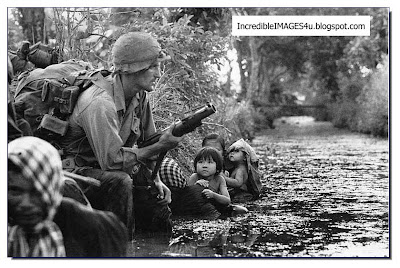
VERBATIM
Thirty-eight years after the last American helicopter
took off from the roof of the U.S. embassy in Saigon, it might not seem
possible for any new book to offer important insights and reporting on
the Vietnam war.
Duc, however, does just that. Uwe Siemon-Netto, a Far Eastern correspondent for Axel Springer Verlag, arrived
in Vietnam in 1965, early enough to see an elegant, Francophile Saigon
not yet metamorphosed into an Asian honkytonk by hordes of GIs, but also
early enough to be an eyewitness to harrowing scenes of the Battle of
Ia Drang, when U.S. Army forces and North Vietnamese regulars clashed
for the first time. Siemon-Netto’s last trip to Vietnam was in 1972,
when the famous North Vietnamese Easter Offensive was well underway.
Unlike some American reporters who seldom ventured
anywhere outside Saigon, Siemon-Netto ranged far and wide across South
Vietnam, dipping in on remote Special Forces bases and brave South
Vietnamese Army units who were cutting down from trees the corpses of
village elders and their children (including babies) who had been strung
up, tortured, and murdered by Communist forces. The author’s love for
Saigon certainly includes forthright admiration for the beauty of
Vietnamese women in their fetching ao dais, but also for the
cocky street urchins who kept his aging Citroen clean and safe by taking
refuge in it when it rained. He also writes admiringly of the German
doctors and nurses who courageously staffed the West German hospital
ship Helgoland, in the face of relentless Vietcong attempts to destroy it, far up north near Da Nang.
Duc is, in parts, hilariously funny, especially
when narrating incidents involving foreign reporters in Vietnam or
describing the perplexity of the Vietnamese encountering Western culture
and social life. But it is also poignant and tragic, especially in
reporting the viciousness of the Tet Offensive of February 1968, which
Siemon-Netto experienced close-up in Saigon, and whose brutal and bloody
aftermath he witnessed in Hue.
He describes weeping Marines coming across hundreds of
women and children murdered by the Vietcong on their way to enjoy the
holiday. Then, slowly, the full horror of the Tet atrocity emerging when
it became clear that the Vietcong had targeted at least 3,000 South
Vietnamese civilians on written execution lists even before the
offensive started. When this fastidious German reporter came upon a mass
grave of victims, he was astonished to find an American television crew
standing around with idle cameras. The crew refused to shoot the scene
because, they said, they didn’t want to film “anti-Communist
propaganda.”
Because he loved the Vietnamese so much, Siemon-Netto
became deeply angry that the murderous brutality of the Communist side
was never fully reported by American or other Western reporters. Vo
Nguyen Giap, the North Vietnamese commander, supervised a military
campaign that deliberately terrorized civilians, understanding that, in
Giap’s own words, “the enemy does not possess the psychological and
political means to fight a long, drawn-out war.”
Unfortunately, General Giap turned out to be correct in
his cynicism: Democratic societies are too vulnerable to their own
doubts and critics to stomach the vigorous and costly struggle needed to
defeat persistent and ruthless tyrannies.
Siemon-Netto was, of course, well aware of some of the
civilian murders perpetrated by American soldiers. He personally
reported on the court-martial of Lt. William Calley for his role in the
My Lai massacre. There is also a touching scene in which he meets an
American machine-gunner who was desolate with grief and contrition
because the black-clad figures he had earlier gunned down had turned out
to be children. But Siemon-Netto makes it clear that the chasm between
Vietcong and American murders was galactic in size: The Communists
carefully planned violence against civilians, whereas the Americans
punished anyone they could prove had committed such acts.
Ultimately, it was the South Vietnamese who suffered most
from the war, ending up under the tyrannical rule of a Hanoi regime that
continued to murder thousands of South Vietnamese military and
civilians even after it had won the military victory. Duc is a
rhapsody of admiration for the warm and talented people of South Vietnam
and for those, both Vietnamese and American, who struggled, and often
gave their lives, to try to keep the country free.
David Aikman is the author, most recently, of The Mirage of Peace: Understanding the Never-Ending Conflict in the Middle East.

No comments:
Post a Comment